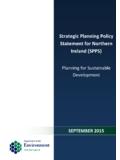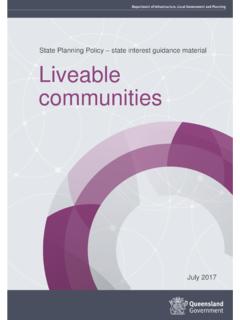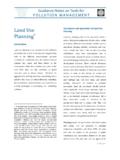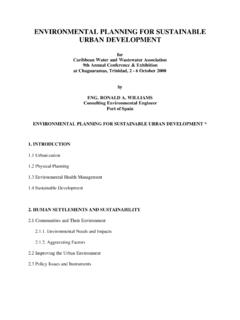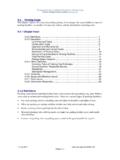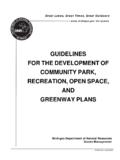Transcription of Goals, Policy Objectives, Key Plan Concepts, and ...
1 Regional Transportation Plan 2030 November 2006 Goals, Policy Objectives, Key Plan Concepts, and Recommendations/Implementation StrategiesRegional Transportation Plan 2030 November 2006 Regional Transportation Plan 2030 November 2006 7 The plan goals and Policy objectives outlined below guided the design and preparation of the plan, and will continue to provide a Policy framework for decision-making for the overall transportation system following plan goals and Policy objectives are organized into three sections. The first section covers the overall transportation system. It includes the plan s overall goal of an integrated and balanced land use and transportation system (see Goal # below) and a second goal describing the desired characteristics of the transportation system. The second section addresses land use and transportation coordination. The third section includes the different elements of the transportation system. Policy objectives describing strategies for achieving the goals follow in each section.
2 Key plan concepts are also actions follow the goals and Policy objectives for land use and transportation coordina-tion and each element of the transportation system. They include facility recommendations and planning and program ac-tions for carrying out the goals and Policy objectives. The primary implementing agencies and/or organizations are noted for each Transportation System Goals#1 Integrated Transportation and Land Use SystemDevelop an integrated and balanced land use and transportation system which provides for the efficient, effective and safe movement of people and goods, promotes the regional economy, supports transportation-efficient development patterns and the regional land use plan, and provides mode choice wherever possible while enhancing and, where relevant, pre-serving the character and livability of the neighborhoods where transportation facilities are located.#2 Transportation System CharacteristicsAchieve a transportation system that is:Balanced provides a range of transportation options and takes advantage of the inherent efficiencies of each serves all areas of the region and all residents and maximizes mobility provided by existing and new facilities through systems and demand management designed, built, and operated to minimize risk of harm to persons and property, and allows persons to feel confident and secure in and around all modes of minimizes and alerts persons to unexpected travel provides an equitable level of service and benefits among demographic and user groups, including low-in-come, minority, the elderly, and persons with disabilities.
3 Interconnected provides for ease of transfer between the different modes of responsible minimizes negative environmental impacts and energy consumption to the extent of compact and efficient patterns of development integrates transportation and land use planning in support of transportation efficient development ( , walkable neighborhoods, transit-oriented activity centers) that maximizes travel, housing, and employment of the social and economic activity of the region provides convenient travel for all persons and efficient movement of to community needs and neighborhood impacts is flexible and adaptable and addresses negative impacts, particularly in residential viable and financially stable is cost efficient and financially feasible with sufficient ongoing financial sup-port for operations and maintenance. Goals and Policy Objectives, Key Plan Concepts, andRecommendations/Implementation StrategiesRegional Transportation Plan 2030 November 2006128 Policy Objectives#1 Public InvolvementAttain an area-wide transportation planning process responsive to the needs and interests of area-wide residents, groups, units of government and affected agencies, with sufficient opportunity for all to participate in Policy and implementation decisions.
4 #2 System PreservationMaintain the region s transportation infrastructure and preserve transportation corridors, particularly rail corridors, for possible future travel uses by other modes.#3 Accessibility and MobilityImprove regional mobility and accessibility for all persons while maintaining a balance between the two sometimes com-peting concerns.#4 SafetyImprove transportation safety through design, operations and maintenance, system improvements, support facilities, pub-lic information, and law enforcement efforts.#5 Balanced SystemAchieve a balanced transportation system through investment in improvements across all modes of travel.#6 Management/OperationsApply Intelligent Transportation Systems (ITS) technologies and utilize Travel Demand Management and Transportation Systems Management (TSM) strategies to respond to traffic congestion, make efficient use of existing roadway capacity, and make the transportation system more reliable, convenient, and safe.#7 Land Use/Transportation ConnectionUse public decisions on the provision of publicly financed transportation facilities and services as a tool for creating com-pact, well-designed and balanced communities.
5 #8 Timing of ImprovementsStage the extension and expansion of urban transportation services within urban service areas, to encourage compact ur-ban growth in accord with regional and local development plans and policies.#9 Congestion ManagementConsider all mobility options and operational strategies (ITS, TDM, TSM) in congested corridors before adding capacity for general purpose travel lanes or building new facilities.#10 Interconnected SystemEncourage and facilitate connections between various modes of travel, including connections with inter-city bus and rail.#11 DesignEncourage attention to aesthetics in the design of transportation improvements to fully integrate improvements into the environment, including consideration of scenic views and vistas, landscaping (with use of native species where possible) along roadsides and boulevards, and the location of signing.#12 Intergovernmental CoordinationContinue to enhance intergovernmental coordination in land use and transportation planning , project development, and operations and maintenance to ensure protection of transportation investments and make efficient use of limited resources.
6 #13 Basic ServicesSupport and maintain basic transportation services such as maintenance, snow removal, traffic control, street sweeping, and other Transportation Plan 2030 November 2006 9#14 FreightEnhance mobility and safety for goods movement to support the local economy while maintaining community livability.#15 Financial FeasibilityEnsure that existing and future financial resources are realistic, reliable, and Use and Transportation System CoordinationThere is a close inter-relationship between land use development and the transportation system. The location, type, and intensity of development determine the need for transportation facilities and services. The region s land use development pattern plays an important role in determining the viability of mode choice options and the safety and efficiency of the transportation system. At the same time, transportation strategies can support the regional land use plan, the preservation of neighborhoods, and minimize undesirable impacts from the transportation system on the environment.
7 The following goal, Policy objectives, and recommendations/implementation strategies address this land use transportation : Coordinate land use and transportation planning and decision-making in a manner that fosters compact urban devel-opment patterns that support and are supported by a balanced, safe, and efficient transportation Objectives#1 Promote the development of balanced communities with sufficient commercial, industrial, residential, and open space land to meet the needs of existing and future residents.#2 Support and maintain downtown Madison as the region s major activity center and seek greater diversity and vitality in that area.#3 Encourage the concentration of higher density, mixed-use, pedestrian-friendly employment/activity centers at nodes and along transit corridors to maximize the efficiency of the existing and future transportation system.#4 Encourage the redevelopment of established employment/activity centers, transit corridors, and other areas, where appropriate, in order to make efficient use of existing transportation infrastructure, expand job-housing choices, improve pedestrian and bicyclist safety and accessibility, and support transit service.
8 #5 Encourage mixed-use neighborhoods with pedestrian-friendly centers or focal points ( , shopping district, commu-nity center, park, etc.) and higher density residential uses closest to these centers and transit routes, thus facilitating shorter trips that make walking, bicycling, and public transit to be more convenient and effective transportation alternatives.#6 Encourage land use development patterns and site designs that maximize the safety and efficiency of the transportation system.#7 Provide non-interchange crossings of limited access roadways to improve mobility and access for motorists, transit us-ers, bicyclists, and pedestrians in coordination with local land use development planning . #8 Encourage intergovernmental cooperation concerning land use and transportation Strategies#1 Continue undertaking a reform or modernizing of land use development ordinances and engineering standards ( , street design) to remove regulatory barriers that prevent the design of compact, mixed-use, pedestrian-friendly develop-ment.
9 [Local governments]The City of Madison is planning to undertake a comprehensive revision of its existing zoning ordinance. Special empha-sis will be placed on creating new mixed-use zoning districts, a traditional neighborhood development (TND) district, and zoning standards for transit-oriented development (TOD). Many other area communities have begun the process of reforming their land use ordinances to remove barriers to mixed use, pedestrian-friendly Transportation Plan 2030 November 2006130#2 Consider requiring or using incentives for providing transit, bicycle, and pedestrian improvements in new commercial, public, mixed-use, and multi-family residential developments. [Local governments]#3 Work with Metro Transit staff to ensure that new developments are planned and designed to be transit-supportive and include transit support facilities, wherever appropriate and feasible. [Local governments, Metro Transit]#4 Adopt transit-oriented development (TOD) zoning, where appropriate, such as in areas identified as likely rail transit station sites in the Transport 2020 and Streetcar studies and other key transit corridors.
10 [City of Madison and other local governments]Key Plan ConceptsThe following are key plan concepts designed to achieve the overall transportation system and land use transportation system coordination goals and Policy objectives. The concepts address the transportation system in a multi-modal manner and inform the mode-specific goals, Policy objectives, and recommendations/implementation strategies that Area and Activity Center LinkageThe plan seeks to maintain mobility and accessibility options throughout the region. Figure 40, on the next page, illus-trates how the major employment/activity centers and cities/villages in the Madison Area are interconnected by the present system of arterial and collector roadways, and how these centers and communities can be served with a potential rail and express bus system with park-and-ride lots. As the outlying communities continue to grow, rail service could be extended in the TransportationThe plan strives to increase use of travel alternatives to driving alone and to minimize demand on the transportation system during peak travel periods.

